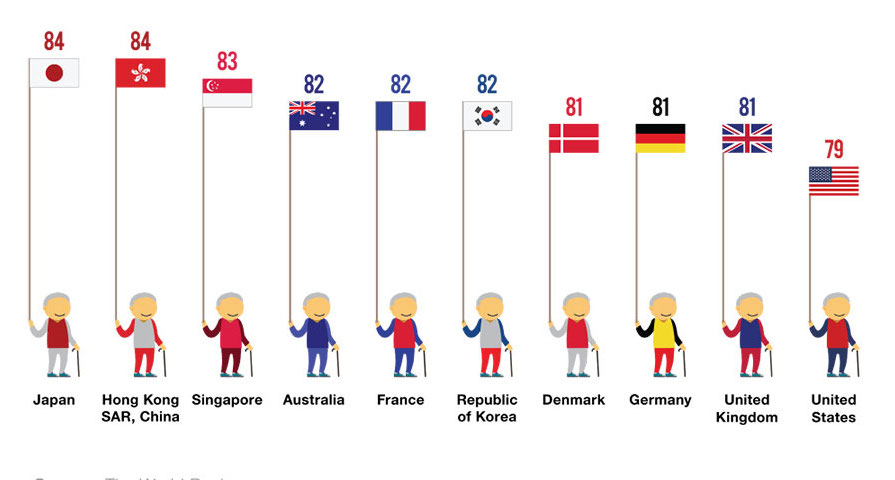SHIFT FROM “SICK-CARE” TO “HEALTH-CARE”


LIFE EXPECTANCY AT BIRTH
BY MERRITT DANIELS – The United States spends more on healthcare than any other country in the world. Yet, the U.S. still ranks lower than several other nations in healthy life indicators, such as 42nd in life expectancy and 56th in infant mortality . Current unsustainable costs, poor outcomes, frequent medical errors, poor patient satisfaction and worsening health disparities all serve as indicators towards a need for change. The success of our nation relies on the health and abilities of American citizens. Healthy and active students come to school ready and able to learn; employees who do not suffer from any mental and physical ailments take fewer sick days, are more productive, and have a positive impact on the economy; and senior citizens who remain physically and mentally active are more likely to live independently longer. Therefore, disease prevention needs to be a part of our everyday lives, including how? people live, work, learn, and play.
Ask yourself this question, “why do I go see a doctor?” The most common answers seem to be “to feel better” or “because I’m sick.” The practice of medicine in the United States has been focused on treatment, on addressing and relieving current symptoms. Yes, doctors are taught to battle disease and treat chronic illnesses. Yes, amazing technological advancements and treatments have been made to save and prolong lives. However, the costs and health outcomes do not seem to match up for the U.S.
What if patients and physicians decided to change how they view and think about healthcare? What if we focused on prevention, rather than treatment? Shifting our nation’s focus toward preventative healthcare has the possibility of not only cost savings, but more importantly, improving American lives. A recent study suggested that increasing the use of preventive services in the U.S. could avert the loss of more than two million lives per year, as well as, saving close to $3.7 billion, or 0.2 percent of U.S. personal health care spending. Perhaps a shift from “sick-care” to “health-care” is exactly what the doctor.
 The Affordable Care Act, also known as Obamacare, was intended to increase patient access to preventive care. But in reality, locating and making timely appointments with physicians who participated in the Affordable Care Act exchanges was extremely difficult. Ultimately, this restricted preventive care access to patients. In order for our nation’s healthcare system to shift to one focused on prevention and wellness from one focused on sickness and disease, government efforts alone will not be enough. In order to see such a shift in U.S. healthcare, the government, physicians, and patients must all work towards a common goal. Patients need to take an active role in their overall health, by being aware of their diet and exercise and taking advantage of the preventative services that are aimed at maintaining and improving their health. Primary care physicians need to adapt a whole-person healthcare approach, by focusing on each patient as a whole and not just the problematic symptoms. Perhaps with prevention at the forefront of our healthcare system, we can decrease the prevalence of acute cases and improve the quality of life for American citizens as a whole.
The Affordable Care Act, also known as Obamacare, was intended to increase patient access to preventive care. But in reality, locating and making timely appointments with physicians who participated in the Affordable Care Act exchanges was extremely difficult. Ultimately, this restricted preventive care access to patients. In order for our nation’s healthcare system to shift to one focused on prevention and wellness from one focused on sickness and disease, government efforts alone will not be enough. In order to see such a shift in U.S. healthcare, the government, physicians, and patients must all work towards a common goal. Patients need to take an active role in their overall health, by being aware of their diet and exercise and taking advantage of the preventative services that are aimed at maintaining and improving their health. Primary care physicians need to adapt a whole-person healthcare approach, by focusing on each patient as a whole and not just the problematic symptoms. Perhaps with prevention at the forefront of our healthcare system, we can decrease the prevalence of acute cases and improve the quality of life for American citizens as a whole.
